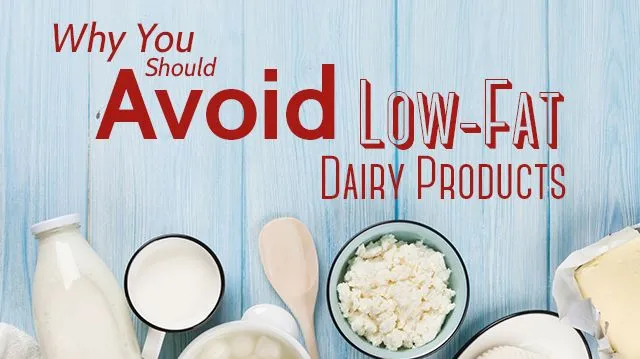
- Share on Facebook1423
- Share on Pinterest
- Share on Twitter
Surprisingly, the myth suggesting low-fat dairy is better for you than full fat still circulates. Yet, a growing body of scientific evidence challenges those long-held beliefs that low-fat milk and dairy products are better for your health. Recent studies suggest that high-fat dairy does not cause obesity or contribute to diabetes and cardiovascular disease; in fact, it may even help prevent it. Here’s why you should consider switching your low-fat yogurt for full fat.
Dairy fat won’t make you fat
When it comes to fat, dairy products in particular continue to be the focus of debate. It seems that controversy continues to brew regarding which type of fat is better for your health — low fat or full fat. Dietary guidelines have long recommended low-fat or nonfat dairy over full-fat or whole milk products, which are higher in saturated fats.
However, new research now suggests that what we mistakenly thought was bad for our health could in fact be good for our health. A meta-analysis published in the European Journal of Nutrition found that people who drink whole milk are likely to weigh less and have lower rates of obesity than those who choose low-fat or skim milk products. The evidence concluded that dairy fat or high-fat dairy foods do not contribute to obesity or cardiometabolic risk.
Another study conducted over a 16-year period involved 1,529 adults aged 25 to 78 years, who habitually consumed high- or low-fat dairy milk, yogurt and full-fat cheese. The study concluded that high-fat dairy products were not linked to mortality. In fact, research suggested that eating full-fat dairy might actually be beneficial for cardiovascular health, although further research is needed.
Low-fat dairy and the link to infertility
If you’re trying to conceive, you may want to reconsider eating low-fat dairy, or at the very least consume less than one serving per week. A study conducted at the Harvard School of Public Health found that women who ate two or more servings of low-fat dairy foods per day, mainly skim milk and yogurt, actually increased their risk of infertility by over 85 percent — compared to women who ate less than one serving of low-fat dairy food per week.
Researchers followed 18,555 married, premenopausal women without a history of infertility who attempted to get pregnant or became pregnant during an eight-year period. Their diet was assessed twice during the study period using food-frequency questionnaires. The study concluded that a high intake of low-fat dairy foods actually increased the risk of infertility. Conversely, the study suggested that high-fat dairy foods may actually decrease this risk.
High-fat dairy may reduce your risk of colorectal cancer
High-fat dairy foods contain several potentially anticarcinogenic factors, including conjugated linoleic acids (CLA), a group of compounds found in the fatty acid linoleic acid. “Conjugated linoleic acid is used for cancer, ‘hardening of the arteries,’ (atherosclerosis), obesity, weight loss caused by chronic disease, bodybuilding, and limiting food allergy reactions,” suggests WebMD.
It turns out that CLA may also have beneficial effects on colorectal cancer. A study conducted by the National Institute of Environmental Medicine at the Karolinska Institutet in Stockholm, Sweden, examined the link between long-term high-fat dairy food consumption, CLA intake and the incidence of colorectal cancer.
The study consisted of 708 women aged 40 to 76 years of age. The participants consumed high-fat dairy foods and were assessed from 1987 to 1990, and again in 1997. The study suggested that high intakes of high-fat dairy foods and CLA may reduce the risk of colorectal cancer.
Fat is not the enemy
In light of all the recent research that contradicts previous notions on low-fat dairy, the healing properties of full-fat, raw milk was actually touted in the early 1900s as the “milk cure.” Back in the day, raw milk was used as medicine at the Mayo Clinic to successfully treat cancer, allergies, prostate issues, skin problems, kidney disease, urinary tract issues, chronic fatigue and more. Unlike today, the only milk available during that period in history was raw, organic, pesticide-free whole milk, rich in butterfat from pasture-fed cows.
Dr. Crewe, MD, one of the founders of the Mayo Foundation, published an article in Certified Milk Magazine (January 1929) describing the milk treatment as a combination of “detoxifying fast and nutrient dense feeding,” and wrote how diseases, with no similarity, improved quickly on raw milk.
Unfortunately, his medical peers were not as keen. While many physicians agreed on the benefits of dairy products, no one was interested in using it as a treatment alone.
“The chief fault of the treatment is that it is too simple,” wrote Crewe, “and it does not appeal to the modern medical man.”
Dairy fat is not the enemy. It’s satisfying, provides a feeling of fullness and helps us to absorb fat-soluble vitamins. More and more science is proving that low-fat dairy should be avoided and full-fat dairy embraced.
—Katherine Marko
Katherine Marko is a freelance writer, author and blog creator. Her areas of expertise include food, health, style, beauty, business and nutrition. Marko holds a Bachelor of Arts in English, a diploma in photography, graphic design and marketing, and certification in esthetics.
Sources:
http://www.ncbi.nlm.nih.gov/pubmed/22810464
http://www.ncbi.nlm.nih.gov/pubmed/17329264
http://www.nature.com/ejcn/journal/v64/n6/full/ejcn201045a.html
http://www.webmd.com/vitamins-supplements/ingredientmono-826-conjugated%20linoleic%20acid.aspx?activeingredientid=826&
http://ajcn.nutrition.org/content/82/4/894.abstract?
http://www.realmilk.com/health/milk-cure
- Share on Facebook1423
- Share on Pinterest
- Share on Twitter

